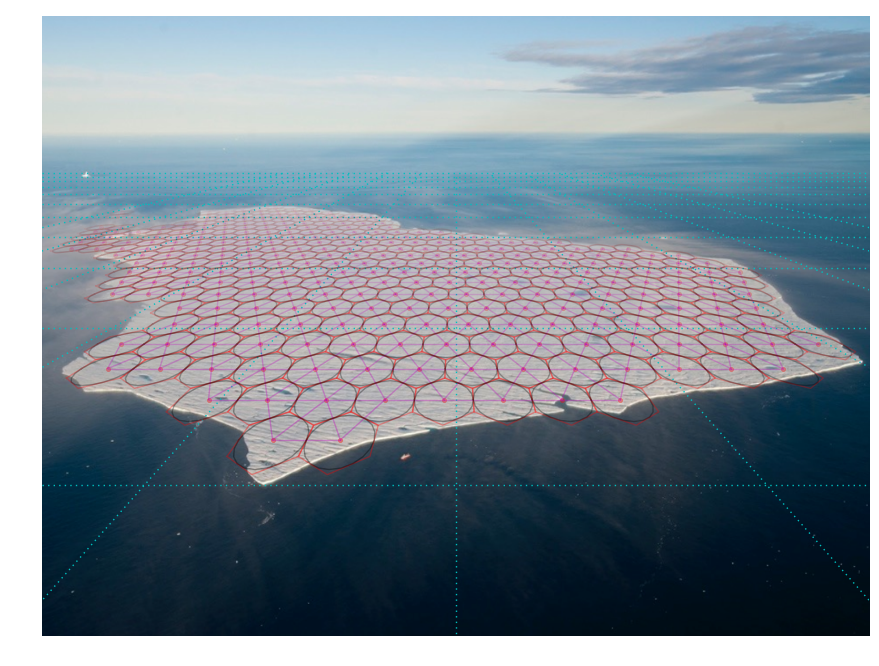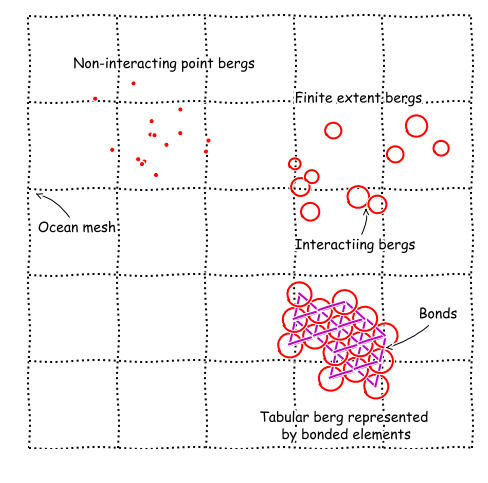Modeling Tabular Icebergs
Contacts for information:
 Alex Huth |
 Olga Sergienko (Princeton) |
 Alistair Adcroft (Princeton) |
Related Areas of Research:
Ocean and Ice Processes
Ice-Ocean Interactions
Ice Sheet Dynamics
Project contributors:
- Alon Stern (former post-doc)

What is special about large tabular icebergs?
Large tabular icebergs can be 100s of meters deep and of order 10s to 100s of kilometers on a side. They break off from ice shelves in “calving events” and account for about 90% (by mass) of all the ice that is calved from the Antarctic ice shelves. For context, about half of the mass loss by Antarctic ice shelves is due to calving, the rest through basal melting. The calving events that create large tabular icebergs are infrequent, often with many decades between events. The resulting tabular icebergs have long lifetimes due to their immense size, sometimes lasting a decade. They drift in the ocean for long distances, interacting with the local ocean circulation, impacting bottom-water formation, sea-ice formation, and biological productivity in the vicinity of the icebergs. However, due to their large horizontal extent and mass, it is challenging to consistently represent large tabular icebergs in global ocean circulation models and so large tabular icebergs are not currently represented in our coupled earth system models.
The Kinematic Iceberg Dynamics (KID) module

We have developed a novel framework to model large tabular icebergs submerged in the ocean known as Kinematic Iceberg Dynamics (Stern et al., 2017), or KID, part of the family of models we use at GFDL to simulate the coupled Earth system. In this framework, a tabular iceberg is represented by a collection of Lagrangian elements that are linked through rigid bonds (see figure 1). The Lagrangian elements are finite-area modifications of the point-particles used in previous studies to represent small icebergs (Martin and Adcroft, 2010; Stern et al., 2016), see figure 2. These elements interact with the ocean by exerting pressure on the ocean surface, and through melt water and momentum exchange. The model source code is open source/open development, and can be found on GitHub at NOAA-GFDL/KID.
Idealized simulations of a calving event
In the animation below we show a simulation of an idealized calving event in which a piece of ice is detached from an ice shelf by manually breaking bonds. The top panel of the animation shows the surface temperature in color, and white/grey indicate thick/thin ice (ice shelf or iceberg). The ice shelf is to the left and open ocean to the right. The dashed line indicates the location of the vertical section shown in the lower panel. In the lower panel, the colors represent interior ocean temperatures. The profile of the ice is evident because ice displaces water, which we properly account for in this model. This simulation of the calving and drift of a tabular iceberg demonstrates the capabilities of KID, and the potential for representing large tabular icebergs within climate models.
The “improved” Kinematic Iceberg Dynamics (iKID) module
In 2022, we introduced the “improved” KID (iKID), which accounts for additional iceberg physics including grounding drag, torque and shear between bonded elements, and stress-induced fracture (bond-breaking). It is formulated using a multiple time-stepping scheme to efficiently integrate of the equations of motion, facilitating coupling with climate models. The iKID framework can simulate observed iceberg behavior, such as the drift and breakup of iceberg A68a in December, 2020 (Huth et al., 2022). This simulation revealed a new mechanism of iceberg breakup not previously reported: ocean-current shear. See Simulating the Breakup of Giant Tabular Iceberg A68a.
References
Huth, A., A. Adcroft, O. Sergienko, and N. Khan, 2022: Ocean currents break up a tabular iceberg. Science Advances, 8(42), eabq6974. doi:10.1126/sciadv.abq6974.
Stern, A.A., A. Adcroft, O. Sergienko, 2019: Modeling ice‐shelf cavities and tabular icebergs using Lagrangian elements. Journal of Geophysical Research: Oceans, 124, doi:10.1029/2018JC014876.
Stern, A.A., A. Adcroft, O. Sergienko, and G. Marques, 2017: Modeling tabular icebergs submerged in the ocean. Journal for Advances in Modeling Earth Systems, 9, 1948– 1972, doi:10.1002/2017MS001002.
Stern, A.A., A. Adcroft, and O. Sergienko, 2016: The effects of Antarctic iceberg calving-size distribution in a global climate model. Journal of Geophysical Research: Oceans, 121, 5773–5788, doi:10.1002/2016JC011835.
Martin, T. and A. Adcroft, 2010: Parameterizing the fresh-water flux from land ice to ocean with interactive icebergs in a coupled climate model. Ocean Modelling, 34, 111–124, doi:10.1016/j.ocemod.2010.05.001.


